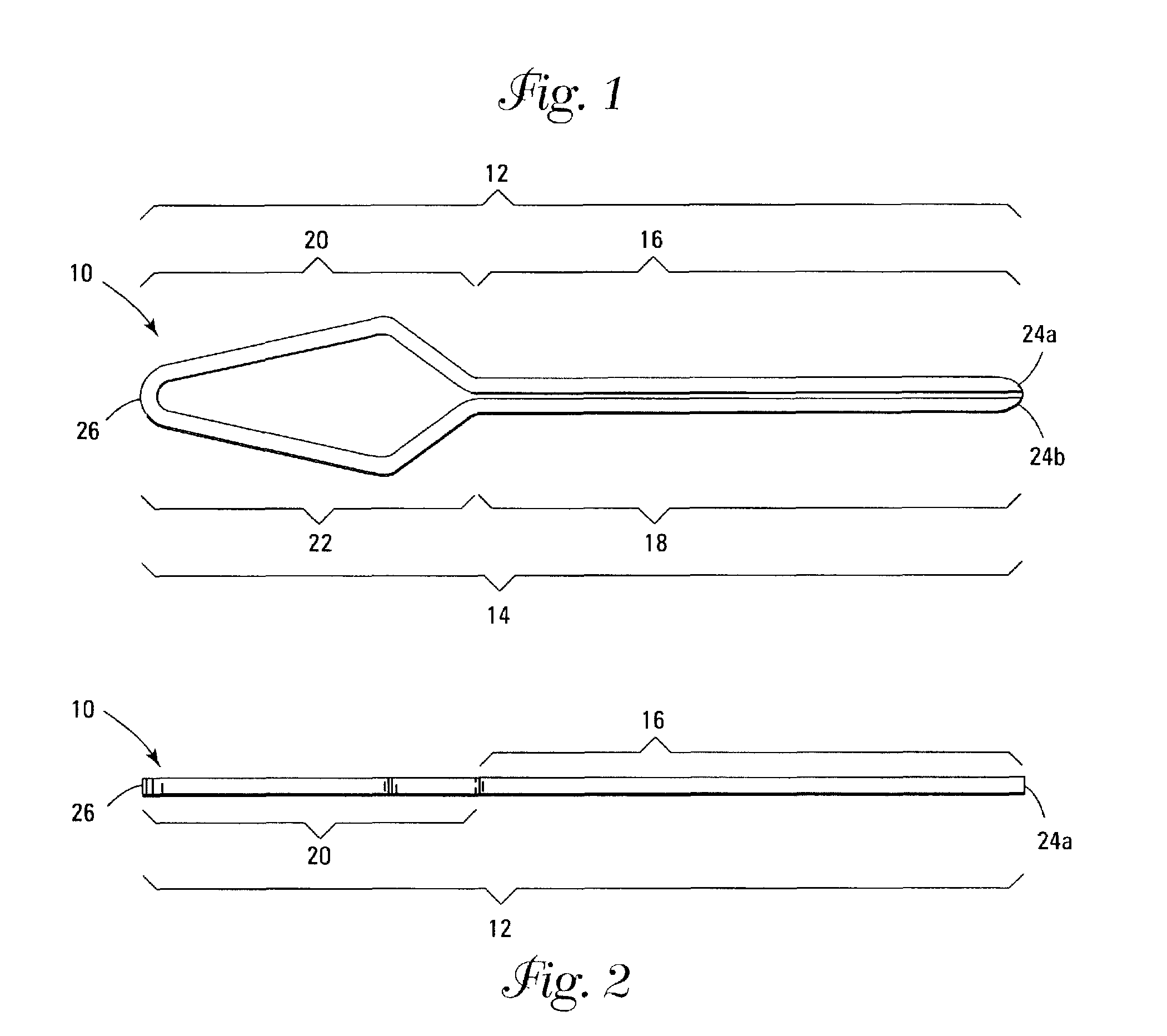Non-invasive surgical ligation clip system and method of using
a ligation clip and non-invasive technology, applied in the field of ligation clips, can solve the problems of inability to reposition the clip after initial placement using the system in thronton et al., limited system, and relatively low elasticity of stainless steel
- Summary
- Abstract
- Description
- Claims
- Application Information
AI Technical Summary
Benefits of technology
Problems solved by technology
Method used
Image
Examples
fifth embodiment
[0030]FIG. 10 shows the clip 500 which is similar to the clip 10 of FIG. 1 except for the lack of a flexing portion on the second jaw 514. This necessitates a longer clamping section 518 on the second jaw 514. The effect of only a single flexing portion 520 is to lessen the amount of force exerted by the clip 500 as a result of clamping. The ligation clip 500 defines at least a first 512 and second jaw 514, which have a longitudinal orientation. The first jaw 512 defines a clamping portion 516 and a flexing portion 520. The second jaw 514, however, defines a only a clamping portion 518. In this embodiment, the clamping portions 516, 518 are parallel with each other and should contact each other or nearly so when in a non-stressed state, only along that portion of their lengths where the clamping portion 516 of the first jaw 512 corresponds with the clamping portion 518 of the second jaw 514. Both first 512 and second 514 jaws define distal ends, 524a, 524b, which are not connected t...
sixth embodiment
[0031]FIG. 11 shows the clip 600, which is similar to the clip 500 shown in FIG. 10. The difference is that the clip 600 has an indentation 617 in the clamping portion 616 of the first jaw 612. The indentation 617 allows the clip 600 to exert less force against the clamped anatomical structure should less force be necessary. An additional advantage to having an indentation 617 is that it may help to guide or seat the structure and prevent the structure to be clamped (not shown) from being forced out of the clip 600 during the clamping procedure. The ligation clip 600 defines at least a first 612 and second jaw 614, which have a longitudinal orientation. The first jaw 612 defines a clamping portion 616 and a flexing portion 620. The second jaw 614, however, defines only a clamping portion 618. In this embodiment, the clamping portions 616, 618 should contact at least a portion of each other or nearly so when in a non-stressed state. Both first 612 and second 614 jaws define a distal ...
seventh embodiment
[0032]FIG. 13 shows the clip 800 that defines a first jaw 812 and a second jaw 814. The first jaw 812 defines a clamping portion 816 which terminates at a distal end 824a and a flexing portion 820. In a similar manner, the second jaw 814 defines a clamping portion 818, which terminates at a distal end 824b and a flexing portion 822. The first jaw 812 and second jaw 814 are joined at a proximal end 826 of the clip 800. The clamping portions 816, 818 cross over each other so as to exert a greater amount of force against a clamped anatomical structure (not shown in FIG. 13).
[0033]In a preferred embodiment, the clip 10, 100, 200, 300, 400, 500, 600, 800 is formed from a single length of nitinol wire that has been processed to exhibit superelasticity at human body temperature (around 37 degrees C.). The invention also contemplates forming the clip 10, 100, 200, 300, 400, 500, 600, 800 from nitinol processed to exhibit thermal shape memory characteristics at human body temperature. Nitino...
PUM
| Property | Measurement | Unit |
|---|---|---|
| stress | aaaaa | aaaaa |
| shape | aaaaa | aaaaa |
| clamping force | aaaaa | aaaaa |
Abstract
Description
Claims
Application Information
 Login to View More
Login to View More - R&D
- Intellectual Property
- Life Sciences
- Materials
- Tech Scout
- Unparalleled Data Quality
- Higher Quality Content
- 60% Fewer Hallucinations
Browse by: Latest US Patents, China's latest patents, Technical Efficacy Thesaurus, Application Domain, Technology Topic, Popular Technical Reports.
© 2025 PatSnap. All rights reserved.Legal|Privacy policy|Modern Slavery Act Transparency Statement|Sitemap|About US| Contact US: help@patsnap.com



